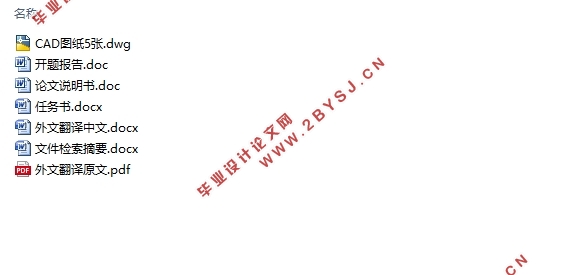汽车磁流变液力缓速器制动性能分析研究(含CAD零件图装配图)
无需注册登录,支付后按照提示操作即可获取该资料.
汽车磁流变液力缓速器制动性能分析研究(含CAD零件图装配图)(任务书,开题报告,外文翻译,文献摘要,论文说明书25000字,CAD图5张)
摘 要
公路运输是我国货物运输行业的主要运输方式之一,也是货物运输量增长的重点。公路货物运输以重型汽车运输为主,在我国2/3的国土面积为山区,山区和丘陵坡路路面较多,而对于山区运输车辆不可避免的需要进行长时间制动,引起行车制动器热衰退,刹车失灵等问题。而安装液力缓速器,是减轻行车制动器负担,以实现长时间平稳制动的最佳方案。
本文研究的磁流变液力缓速器,不同于普通的液力缓速器,其为传动工质全密封没有充放液过程。由于作为传动液的磁流变液是可控液体,在流变效应下,其粘度可由磁场控制,磁场变化后可在几十ms内达到流变平衡,故磁流变液力缓速器在工作中响应迅速。
本文的主要内容如下:
(1)首先,基于液力缓速器基本的流场理论,从流体角度分析液力缓速器制动力矩的产生原因,研究径向直叶片和倾斜叶片的作用力矩表达式,并以此选取合适的实验样机,分析普通离心泵和实验样机的流场,获得轴向分速度与相对速度和叶片半径的对应关系,以牛顿流体和Bingham流体推导液力缓速器制动力矩的公式;
(2)其次,确定线圈位置和线圈的运动形式,基于磁学设计原理,选择适合的磁轭、隔磁环和隔磁板材料,分析剩磁、漏磁以及磁路材料对磁路的影响,完成完整的磁路设计;
(3)最后,在前两部分分析计算的基础上,对液力缓速器磁-液进行了耦合分析计算,完成对液力缓速器的制动性能分析。
通过详尽的理论分析,得出磁流变液液力缓速器中磁流变液的流变效应对制动力矩的影响,是否能够有效调节液力缓速器的制动力矩。
关键词::液力缓速器;磁流变液;基础流体力学;制动力矩
Abstract
Road transport is one of the main modes of transport of China's cargo transportation industry, and also the focus of the growth of cargo traffic. Road transport of goods to heavy-duty vehicle transport, in our country 2/3 of the land area for the mountains, mountain and hilly slope road more, and for the mountain transport vehicles inevitably need a long time to brake, causing the car brake heat recession , Brake failure and other issues. The installation of hydraulic retarder, is to reduce the burden of driving brakes to achieve the best long-term smooth braking program.
In this paper, the study of the magneto-rheological hydraulic retarder, is different from the ordinary hydraulic retarder, which is the transmission of the whole state is not charge and discharge process. Since the magnetorheological fluid as the transmission fluid is a controllable liquid, the viscosity can be controlled by the magnetic field under the rheological effect, and the
rheological balance can be achieved within several tens of ms after the magnetic field changes. Work responded quickly.
The main contents of this paper are as follows:
(1) Based on the theory of the basic flow field of the hydraulic retarder, the causes of the braking torque of the hydraulic retarder are analyzed from the perspective of the fluid, and the torque moments of the radial straight blade and the inclined blade are studied. The corresponding experimental prototype is selected to analyze the flow field of the ordinary centrifugal pump and the experimental prototype. The relationship between the axial velocity and the relative velocity and the blade radius is obtained. The formula of the braking torque of the hydraulic retarder is deduced by Newtonian fluid and Bingham fluid.
(2) Secondly, to determine the coil position and the movement of the coil form, based on the principle of magnetic design, select the appropriate yoke, magnetic isolation and magnetic plate material, analysis of remanence, magnetic flux and magnetic circuit materials on the magnetic circuit , Complete the complete magnetic circuit design;
(3) Finally, based on the analysis of the first two parts, the coupling analysis and calculation of the magnetic retarder of the hydraulic retarder are carried out to complete the braking performance analysis of the hydraulic retarder.
Through detailed theoretical analysis, it is concluded that the effect of the rheological effect of the magnetorheological fluid on the braking torque in the MR fluid hydraulic retarder can effectively adjust the braking torque of the hydraulic retarder.
Keywords: Hydraulic retarder;Magnetorheological fluid;Basic fluid mechanics;Braking torque



目 录
第1章 绪论 1
1.1 课题背景及研究意义 1
1.2 液力缓速器概述 1
1.2.1 液力缓速器的结构组成与工作原理 1
1.2.2 液力缓速器的优缺点 2
1.2.3 液力缓速器不同国家和地区分析的基本情况 3
1.2.3.1其他国家和地区研究和分析的基本情况 3
1.2.3.2国内研究现状 5
1.3 磁流变液综述 5
1.3.1 磁流变液的研究现状 5
1.3.2 磁流变液的组成 6
1.3.2.1 磁性颗粒 6
1.3.2.2 载液 6
1.3.2.3 添加剂 7
1.3.3 磁流变液的流变特性 7
1.3.3.1磁流变效应 7
1.3.3.2 磁流变液宏观模型 8
1.3.4 磁流变效应的作用要素 9
1.4 研究的主要内容 10
第2章 磁流变液液力缓速器理论分析与试验样机选择 13
2.1 液力缓速器的流场研究理论 13
2.1.1 一维束流理论 13
2.1.2 二维和三维束流理论 16
2.2 试验样机与磁流变液的选择 16
2.3 普通离心泵的流场分析 16
2.4磁流变液器件的工作模式 18
2.4.1流动模式 18
2.4.2剪切模式 19
2.4.3挤压模式 19
2.5 试验样机的流场分析 19
2.6 叶轮盖板所受力矩的计算 26
2.7本章小结 27
第3章 试验样机的磁路设计 28
3.1 磁学设计原理 28
3.1.1 磁路设计准则和基本方程组 28
3.1.2磁场的产生方式 29
3.1.3 磁学原理 29
3.1.4磁路布置用材料 31
3.1.5影响磁路的主要因素 31
3.2 磁流变液励磁线圈布置方式 32
3.2.1 线圈位置的确定 32
3.2.2 线圈运动形式的确定 32
3.2.3磁流变液各器件的磁路布置设计 33
3.2.1.1磁流变液阻尼器的磁路布置 33
3.2.1.2磁流变液制动器或离合器磁路布置 33
3.3磁流变液试验样机的磁路设计 34
3.4本章小结 37
第四章 磁流变液力缓速器性能分析 38
4.1励磁电流控制制动力矩的推导 38
4.1.1电流强度-磁感应强度控制 38
4.1.2磁感应强度-磁流变液剪切屈服应力控制 38
4.1.3磁流变液剪切屈服应力-叶轮转矩控制 38
4.2汽车制动过程分析 39
4.2.1制动轮受力分析 39
4.2.2整车制动受力分析 40
4.2.3整车制动数学模型 40
4.2.3.1平路减速制动模型 40
4.2.3.2坡道持续制动模型 41
第五章 结论和展望 43
5.1成果与结论 43
5.2不足与展望 43
参考文献 44
致谢 46
